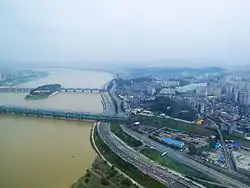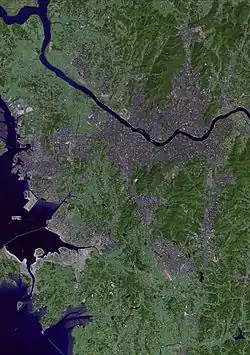Hangang Bridge bombing
The Hangang Bridge bombing (Korean: 한강 인도교 폭파,[1] Hanja: 漢江人道橋爆破) was a demolition operation conducted by the South Korean Army to destroy the Hangang Bridge in Seoul, South Korea, on 28 June 1950, to delay the rapid North Korean advance towards the city.


On 25 June that year, North Korea invaded South Korea, sparking the Korean War. Against a lightly-armed and poorly-equipped South Korean military, the North Korean assault forces and supporting tanks easily overwhelmed their defenses and within two days were positioned extremely close to Seoul.
In the early morning of 27 June, Syngman Rhee had himself evacuated away from Seoul by his special train with several other South Korean government officials, despite informing his country on the previous day (26 June) of the decision by him and his government cabinet to remain behind in the capital city even with the looming threat of a North Korean attack on it.[2] At 11:00 am, the South Korean Army headquarters decided to destroy the Hangang Bridge to stop the North Korean invasion and gave up defending Seoul.[3] From noon to 3:30 pm on 27 June, the South Korean Army planted 3,600 pounds of TNT at the Hangang Bridge in preparation for its demolition.[2][3] At 11:30pm, the demolition warning-order was issued.[3] However, the South Korean Army failed to announce the approaching demolition to Seoul residents.[4]
On 28 June, at 2:30 am, the demolition charges were detonated without warning.[2] On the bridge were some 4,000 refugees crossing the river when it was demolished and between 500 and 1,000 refugees were killed with the bridge's collapse.[5][2][1] The South Korean government said 800 people died in the blast.[1] The South Korean Army's Fifth Division was also cut off from its retreat path, leaving it stranded on the north bank of the Han River and at the mercy of the oncoming North Korean forces.[3][5] At 11:00 am, the North Korean Army then reached the bridge, and shortly after crossing the river, successfully occupied Seoul.[3]
On 21 September 1950, Colonel Choi Changsik was executed for ordering the detonation of the demolition charges.[1] In 1964, Choi's wife pleaded his innocence to an appeal tribunal and the court found Choi as not guilty because the demolition order was issued by his superior officers.[1]
On 28 June 2007, the first memorial service was held by a local veterans' peace association.[1]
See also
References
- "57년 동안 한강 떠돈 원혼들을 위로하다 '한강인도교 폭파 희생자 위령제' 열려... "피난민 내팽게친 이승만은 전범" 출처 : 57년 동안 한강 떠돈 원혼들을 위로하다 - 오마이뉴스". Ohmynews. 2007-06-28. Retrieved 2010-07-16.
- "만물상 6•25 한강다리 폭파의 희생자들". Chosun Ilbo. 2010-06-29. Retrieved 2010-07-16.
- ""한강다리 폭파책임자 역사의 심판대에" 평화재향군인회, 28일 '한강 인도교 폭파 희생자 위령제' 열어". Daily JoongAng. 2007-06-28. Retrieved 2010-07-16.
- "한강대교와 철교, 광진교 복구". Seoul Special City Government. Retrieved 2010-07-16.
- Johnston, William. A war of patrols: Canadian Army operations in Korea. Univ of British Columbia Pr. p. 20. ISBN 0-7748-1008-4.
